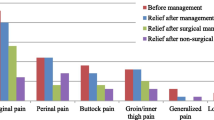Abstract
In 2001, the US Food and Drug Administration (FDA) approved the first transvaginal mesh kit to treat pelvic organ prolapse (POP). Since the introduction of vaginal mesh kits, some vaginal meshes have been associated with chronic pelvic pain after reconstructive pelvic floor surgery. Pelvic pain results in between 0 % and 30 % of patients following transvaginal mesh placement. Common causes of chronic pelvic pain include pelvic floor muscle spasm, pudendal neuralgia, and infection. Paucity of data exists on the effective management of chronic pelvic pain after pelvic reconstructive surgery with mesh. We outline the management of chronic pelvic pain after transvaginal mesh placement for reconstructive pelvic floor repair based on our clinical experience and adaptation of data used in other aspects of managing chronic pelvic pain conditions.

Similar content being viewed by others
References
Perry CP (2001) Current concepts of pelvic congestion and chronic pelvic pain. JSLS 5:105–110
Apte G, Nelson P, Brismee JM, Dedrick G, Justiz R 3rd, Sizer PS Jr (2012) Chronic female pelvic pain-part 1: clinical pathoanatomy and examination of the pelvic region. Pain Pract 12:88–110
Food and Drug Administration (2011) FDA Safety Communication: UPDATE on Serious Complications Associated with Transvaginal Placement of Surgical Mesh for Pelvic Organ Prolapse. FDA, Silver Spring (MD)
Maher C, Baessler K, Glazener CM, Adams EJ, Hagen S (2007) Surgical management of pelvic organ prolapse in women. Cochrane Database Syst Rev 3, CD004014
Rigaud J, Labat JJ, Riant T et al (2008) Treatment of obturator neuralgia with laparoscopic neurolysis. J Urol 179:590–594 [discussion 594-5]
Sentilhes L, Berthier A, Sergent F et al (2008) Sexual function in women before and after trans-vaginal mesh repair for pelvic organ prolapsed. Int Urogynecol J Pelvic Floor Dysfunct 19:763–772
Health Canada. Drugs & health products. Advisories, warnings & recalls. Surgical Mesh – Complications Associated with Transvaginal Implantation of Surgical Mesh for treatment of Stress Urinary Incontinence and Pelvic Organ Prolapse – Notice to Hospitals. February 4, 2010
Marcus-Braun N, Bourret A, von Theobald P (2012) Persistent pelvic pain following transvaginal mesh surgery: a cause for mesh removal. Eur J Obstet Gynecol Reprod Biol 162(2):224–228
Caquant F, Collinet P, Debodinance P, Berrocal J, Garbin O, Rosenthal C et al (2008) Safety of trans vaginal mesh procedure: retrospective study of 684 patients. J Obstet Gynaecol Res 34:449–456
Dwyer P (2006) Evolution of biological and synthetic grafts in reconstructive pelvic surgery. Int Urogynecol J 17(1):S10–S15
Deprest J, Zheng F, Konstantinovic M, Spelzini F, Claerhout F et al (2006) The biology behind fascial defects and the use of implants in pelvic organ prolapse repair. Int Urogynecol J 17(1):S16–S25
Falgas ME, Velakoulis S, Iavazzo C, Athanasiou S (2007) Mesh-related infections after pelvic organ prolapsed repair surgery. Eur J Obstet Reprod Biol 134:147–156
Tu FF, As-Sanie S, Steege J (2006) Prevalence of pelvic musculoskeletal disorders in a female chronic pelvic pain clinic. J Reprod Med 51(3):185–189
Gyang A, Hartman M, Lamvu G (2013) Musculoskeletal causes of chronic pelvic pain. What a gynecologist should know. Obstet Gynecol 121(3):645–650
Letouzey V, Deffieux X, Levaiilolant J et al (2009) Ultrasound evaluation of polypropylene mesh contraction at long term after vaginal surgery for cystocele repair. Int Urogynecol J 20:S205
Spinosa JP, de Bisschop E, Laurencon J, Kuhn G, Dubuisson JB, Riederer BM (2006) Sacral staged reflexes to localize the pudendal compression: an anatomical validation of the concept. Rev Med Suisse 2(84):2416–2418, 20-1
Labat JJ, Riant T, Robert R, Amarenco G, Lefaucheur JP, Rigaud J (2008) Diagnostic criteria for pudendal neuralgia by pudendal nerve entrapment (Nantes criteria). Neurourol Urodyn 27(4):306–310
Shafik A (2002) Pudendal canal syndrome: a cause of chronic pelvic pain. Urology 60:199
Jelovsek JE, Sokol AI, Barber MD, Paraiso MF, Walters MD (2005) Anatomic relationships of infracoccygeal sacropexy (posterior intravaginal slingplasty) trocar insertion. Am J Obstet Gynecol 193:2099–104
Castellanos ME, Yi J, Atashroo D, Desai N, Hibner M (2012) Pudendal neuralgia after posterior vaginal wall repair with mesh kits: an anatomical study and case series. J Minim Invasive Gynecol 19(6):S72–S73
Clavé A, Yahi H, Hammou J, Montanari S, Gounon P, Clave H (2010) Polypropylene as a reinforcement in pelvic surgery is not inert: comparative ananlysis of 100 explants. Int Urogynecol J 21:261–270
Shah HN, Badlani GH (2012) Mesh complications in female pelvic floor reconstructive surgery and their management: a systematic review. Indian J Urol 28(2):129–153
Giamberardino MA, Affaitati G, Fabrizio A, Constantini R (2011) Myofascial pain syndrome and their evaluation. Best Pract Res Clin Rheumatol 25:185–198
Gerwin RD (1999) Myofascial pain syndrome from trigger points. Curr Rev Pain 3:153–159
Abbott JA, Jarvis SK, Lyons SD, Thomson A, Vancaille TG (2006) Botulinum toxin type A for chronic pain and pelvic floor spasm in women: a randomized controlled trial. Obstet Gynecol 108:915–923
Hibner M, Desai N, Robertson LJ, Nour M (2010) Pudendal neuralgia. J Minim Invasive Gynecol 17(2):148–153
Robert R, Prat-Pradel D, Labat JJ, Bensignor M, Raoul S, Rebai R et al (1998) Anatomic basis of chronic perineal pain:role of pudendal nerve. Surg Radiol Anat 20(20):93–98
Chrysos E, Athanasakis E, Saridaki Z, Kafetzakis A, Dimitriadou D et al (2000) Surgical repair of incisional ventral hernias: tension-free technique using prosthetic materials (expanded polytetrafluoroethylene Gore-Tex Dual Mesh). Am Surg 66(7):679–682
Feiner B, Maher C (2010) Vaginal mesh contraction: defintions, clinical presentation and management. Obstet Gynecol 115(2pt1):325–330
Conflicts of interest
None.
Author information
Authors and Affiliations
Corresponding author
Rights and permissions
About this article
Cite this article
Gyang, A.N., Feranec, J.B., Patel, R.C. et al. Managing chronic pelvic pain following reconstructive pelvic surgery with transvaginal mesh. Int Urogynecol J 25, 313–318 (2014). https://doi.org/10.1007/s00192-013-2256-y
Received:
Accepted:
Published:
Issue Date:
DOI: https://doi.org/10.1007/s00192-013-2256-y




